
First Trust Building and Garage, also known as Lloyd's Bank, is a historic 1927 building located on Colorado Boulevard in Pasadena, California. The building was designed by Cyril Bennett and Fitch Haskell; its design incorporates the Mediterranean Revival, Renaissance Revival, and Beaux-Arts styles. The design features decorative exterior stonework, a red tile hip roof topped with a cupola, and a frieze and balustrade on the south facade. The building's interior is decorated with murals depicting scenes from around Pasadena. Caltech professor R. R. Martel designed the building's earthquake-proof support system, which uses steel beams and girders with reinforcing concrete; the system was considered an important advancement in earthquake-proof construction and became a standard form of construction.
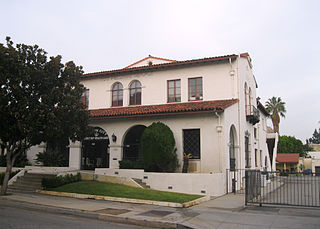
The Odd Fellows Temple in Pasadena, California is a historic building that was built in 1933 at 175 N. Los Robles Ave. The temple served as a meeting place for Odd Fellow Lodge No. 324, the Pasadena branch of the Independent Order of Odd Fellows established in 1885. Pasadena architect Kenneth Gordon designed the building; its design incorporates the Spanish Colonial Revival and Mediterranean Revival styles. The temple is the only Spanish Colonial Revival building in Pasadena which was built for a fraternal organization. It was listed on the National Register of Historic Places (NRHP) in 1985.
In the United States, the National Register of Historic Places classifies its listings by various types of architecture. Listed properties often are given one or more of 40 standard architectural style classifications that appear in the National Register Information System (NRIS) database. Other properties are given a custom architectural description with "vernacular" or other qualifiers, and others have no style classification. Many National Register-listed properties do not fit into the several categories listed here, or they fit into more specialized subcategories.

Friendship Baptist Church is a Baptist church in Pasadena, California. The oldest black Baptist church in Pasadena, the church was built in 1925 to serve a congregation founded in 1893. The church was designed by Norman F. Marsh in the Spanish Colonial Revival style. Its design includes a tower, a bell-gable, a tile roof, and stained-glass windows. It was listed in the National Register of Historic Places on November 20, 1978.

The A. K. Smiley Public Library is a public library located at 125 W. Vine St. in Redlands, California. Built in 1898, the library was donated to Redlands by philanthropist Albert K. Smiley. The library is within Smiley Park Historic District and adjacent the Redlands Bowl and Lincoln Memorial Shrine.
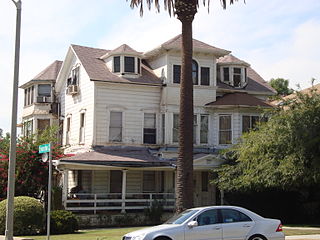
The Evanston Inn is a historic hotel located at 395 S Marengo Ave. in Pasadena, California. The inn was built in 1897 and served as a smaller and less lavish alternative to Pasadena's luxury hotels. The building was designed in a combination of the Queen Anne and Colonial Revival styles, and the original section of the building features decorative shingling. In 1898 and 1905, the inn constructed additional wings due to the growth in Pasadena tourism. The inn is now the only extant wood-frame hotel in Pasadena.

Haskett Court is a bungalow court located at 824–834 E. California Boulevard in Pasadena, California. The court includes five buildings which form a "U" shape around a central walkway; the buildings contain a combined six residential units. Built in 1926, the court was designed by Pasadena architect Charles Ruhe and built by W. B. Haskett, who also lived in one of the homes. The houses in the court were designed to resemble English cottages, and their architecture is similar to the Tudor Revival style. As bungalow courts lost popularity in the 1930s, Haskett Court is one of the later bungalow courts built in Pasadena.

Don Carlos Court is a bungalow court located at 374–386 S. Marengo Ave. in Pasadena, California. The court contains seven homes built around a central courtyard and walkway. The homes were designed in the Spanish Colonial Revival style and were all built with stucco facades and tiled gable roofs. The courtyard includes a decorative birdbath and planter. Contractor Clarence Hudson Burrell built the court in 1927.
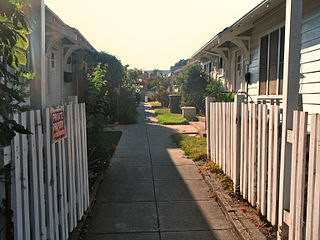
Colonial Court is a bungalow court located at 291–301 N. Garfield Ave. in Pasadena, California. The court consists of six houses arranged around a narrow courtyard. The houses are designed in the Colonial Revival style and feature clapboard siding and jerkinhead roofs. Built in 1916, the homes were designed by architect Cyril Bennett.
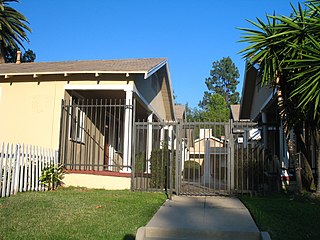
Cottage Court is a bungalow court located at 642–654 S. Marengo Ave. in Pasadena, California. The court consists of seven houses surrounding a narrow courtyard. The stucco homes were built in 1923 and designed in the Colonial Revival style. The designs feature gable roofs with wide eaves and recessed porches with supporting columns. The courtyard includes a walkway and two light poles.
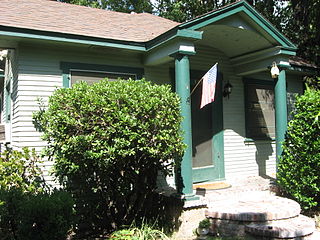
Cypress Court is a bungalow court located at 623–641 N. Madison Ave. in Pasadena, California. The court consists of eight houses surrounding two central walkways. The homes are designed in the Colonial Revival style and feature gable roofs and gabled porches supported by columns. Contractor Arthur G. Gehrig built the court in 1928.

The Court at 497-503½ North Madison Avenue is a bungalow court located at 497-503½ N. Madison Ave. in Pasadena, California.

The Court at 732-744 Santa Barbara St. is a bungalow court located at 732-744 Santa Barbara St. in Pasadena, California. The original court includes three buildings containing five residential units surrounding a central courtyard. Contractor D. Hoffman built the court in 1922. The homes in the court were designed in the Spanish Colonial Revival style and feature porches with tile roofs atop columns and broken parapets along their roofs. A sixth building at 738 Santa Barbara was added in 1956; this building is not considered part of the historic court.

Mission Court is a bungalow court located at 567 N. Oakland Ave. in Pasadena, California. The court consists of eight buildings containing fourteen residential units which surround a central courtyard. Built in 1913, the court was designed by architect J. F. Walker. The houses in the court were designed in the Mission Revival style; the court is the oldest Mission Revival bungalow court in Pasadena. The houses' designs feature broken parapets along the roofs and porches with either recessed arch entrances or tiled shed roofs. The courtyard includes two buttressed piers topped by lamps.

Orange Grove Court is a bungalow court located at 745 East Orange Grove Blvd. in Pasadena, California. The court, which was built in 1924, contains twelve single-family houses arranged along a central walkway. The houses were designed in the Mission Revival style and feature arched porches and windows, stucco exteriors, and tile roofs. A double arch is located at the end of the walkway, a variation on the common practice of placing another home at the end of the walkway in a bungalow court. According to its National Register of Historic Places nomination, the court "epitomizes the concept of the Southern California bungalow court" due to its layout and Mission Revival details.

Rose Court is a bungalow court located at 449-457 S. Hudson Ave. in Pasadena, California. The court has a half-court arrangement with three buildings containing five residential units located alongside a driveway. Built from 1921 to 1922, the court was designed by the architectural firm Stewart, Young & Stewart in the Mission Revival style. The homes feature stucco walls, arched porches, and broken parapets along the roof and reflect a simplified interpretation of Mission Revival architecture.

Sara-Thel Court is a bungalow court located at 618-630 S. Marengo Ave. in Pasadena, California. The court includes seven buildings arranged around a central walkway; six of the buildings are single-family units, while a double unit is located at the end of the walkway. Built in 1921, the court was designed by Jas. Humphreys. The houses were mainly designed in the American Craftsman style and feature gable roofs with shallow slopes and exposed rafters; the moldings on the homes were inspired by the Colonial Revival style.

The Nevada-California-Oregon Railway Co. General Office Building, commonly known as the N.C.O. Building, is a historic site in Alturas, California, listed on the National Register of Historic Places. It was built 1917–1918 to serve as the headquarters of the Nevada-California-Oregon Railway. It has been an Elks Lodge since at least 1974.

The United States Post Office in Petaluma, California, is located at 120 West Fourth Street. The building, completed in 1933, has been listed on the National Register of Historic Places since 1985.

Mary Louise Court is a bungalow court located at 583-599 N. Mentor Ave. in Pasadena, California. Robert Harris built the court in 1928. The court consists of seven buildings surrounding a central pathway; the buildings contain 14 residential units, with four in the rear building, three in each of the two middle buildings, and one each in the front four buildings. The buildings are designed in the Spanish Colonial Revival style and feature stucco exteriors, Spanish tile roofs, open-arched porches, and curved bracketing around the doors. The stone walkway between the homes is lined by palm trees.






















